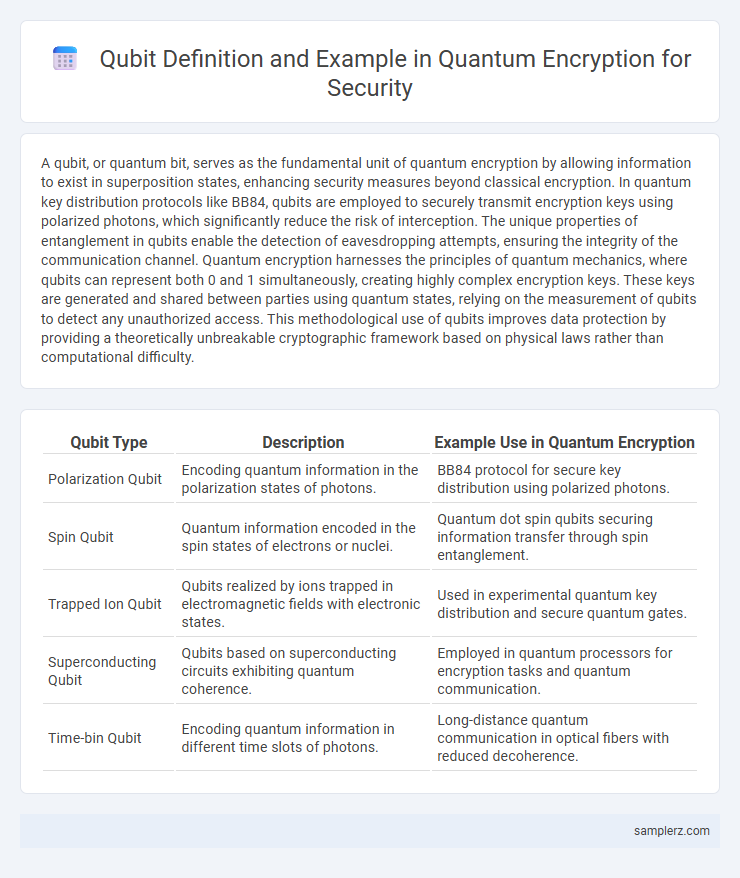A qubit, or quantum bit, serves as the fundamental unit of quantum encryption by allowing information to exist in superposition states, enhancing security measures beyond classical encryption. In quantum key distribution protocols like BB84, qubits are employed to securely transmit encryption keys using polarized photons, which significantly reduce the risk of interception. The unique properties of entanglement in qubits enable the detection of eavesdropping attempts, ensuring the integrity of the communication channel. Quantum encryption harnesses the principles of quantum mechanics, where qubits can represent both 0 and 1 simultaneously, creating highly complex encryption keys. These keys are generated and shared between parties using quantum states, relying on the measurement of qubits to detect any unauthorized access. This methodological use of qubits improves data protection by providing a theoretically unbreakable cryptographic framework based on physical laws rather than computational difficulty.
Table of Comparison
| Qubit Type | Description | Example Use in Quantum Encryption |
|---|---|---|
| Polarization Qubit | Encoding quantum information in the polarization states of photons. | BB84 protocol for secure key distribution using polarized photons. |
| Spin Qubit | Quantum information encoded in the spin states of electrons or nuclei. | Quantum dot spin qubits securing information transfer through spin entanglement. |
| Trapped Ion Qubit | Qubits realized by ions trapped in electromagnetic fields with electronic states. | Used in experimental quantum key distribution and secure quantum gates. |
| Superconducting Qubit | Qubits based on superconducting circuits exhibiting quantum coherence. | Employed in quantum processors for encryption tasks and quantum communication. |
| Time-bin Qubit | Encoding quantum information in different time slots of photons. | Long-distance quantum communication in optical fibers with reduced decoherence. |
Introduction to Qubits in Quantum Encryption
Qubits, the fundamental units of quantum information, leverage superposition and entanglement to enable unparalleled security in quantum encryption protocols. Unlike classical bits, qubits can represent both 0 and 1 simultaneously, allowing quantum key distribution methods such as BB84 to detect eavesdropping attempts with high sensitivity. These unique quantum properties facilitate tamper-proof communication channels essential for next-generation cryptographic security solutions.
Fundamental Properties of Qubits
Qubits, the fundamental units of quantum encryption, exhibit superposition and entanglement, enabling unparalleled security by encoding multiple states simultaneously. Their inherent quantum properties prevent eavesdropping, as any measurement disturbs the system, revealing potential interception. Utilizing qubits ensures cryptographic protocols like Quantum Key Distribution (QKD) achieve provably secure communication resistant to classical hacking methods.
Role of Qubits in Quantum Key Distribution
Qubits serve as the fundamental units of information in Quantum Key Distribution (QKD), enabling secure communication through quantum superposition and entanglement. Their unique quantum states allow for the detection of eavesdropping, as any measurement disturbs the qubit and alerts the communicating parties. This intrinsic property ensures the generation of cryptographic keys with unconditional security, surpassing classical encryption methods.
Real-World Example: Qubit Encoding in BB84 Protocol
The BB84 protocol uses qubits encoded in the polarization states of photons, such as horizontal, vertical, diagonal, and anti-diagonal polarizations, to securely distribute cryptographic keys over a quantum channel. These quantum states enable detection of eavesdropping through the no-cloning theorem and measurement disturbances, ensuring enhanced security compared to classical encryption methods. Real-world implementations involve photons transmitted via fiber-optic cables or free-space links, demonstrating practical quantum key distribution applications.
Superposition and Its Security Benefits in Qubit Systems
Qubits in quantum encryption leverage superposition, allowing them to exist in multiple states simultaneously, which provides a significant security advantage by enabling complex encryption keys that are extremely difficult to predict or replicate. This property enhances the robustness of quantum key distribution (QKD) protocols like BB84, ensuring secure communication through the detection of any eavesdropping attempts. By exploiting superposition, quantum encryption systems dramatically reduce the risk of data breaches compared to classical encryption methods.
Example of Qubit Measurement and Eavesdropping Detection
In quantum encryption, measuring a qubit in polarization states such as |0> or |1> collapses its superposition, revealing any eavesdropping attempts through anomalous error rates. For example, if an eavesdropper measures the qubit in the rectilinear basis while the sender uses a diagonal basis, the shared key detection phase will expose inconsistencies indicating interception. This intrinsic property of qubit measurement enables protocols like BB84 to secure quantum key distribution against unauthorized access.
Entangled Qubits: Enhancing Encryption Security
Entangled qubits play a crucial role in quantum encryption by enabling quantum key distribution (QKD), which ensures secure communication through the detection of eavesdropping attempts. The unique property of entanglement allows quantum keys to be shared with provable security, as any interference alters the entangled state and signals potential breaches. This enhancement in encryption security surpasses classical methods by leveraging quantum mechanics principles, making data virtually unhackable.
Case Study: Qubit Application in Quantum Networks
Qubits serve as the fundamental units in quantum encryption, enabling secure communication within quantum networks by leveraging quantum superposition and entanglement. In a case study involving quantum key distribution (QKD), qubits transmit encryption keys that detect eavesdropping attempts, ensuring unparalleled security. This application highlights qubits' essential role in advancing quantum networks and fortifying digital information against cyber threats.
Future Trends in Qubit-Based Encryption
Future trends in qubit-based encryption highlight the integration of quantum key distribution (QKD) using entangled photon pairs to achieve unprecedented security levels. Advances in error correction and qubit coherence times promise scalable quantum networks capable of withstanding sophisticated cyberattacks. Research on hybrid classical-quantum cryptographic protocols aims to bridge existing infrastructure with quantum-resistant encryption methods.
Challenges and Opportunities with Qubits in Security Systems
Qubits in quantum encryption offer unprecedented security through quantum key distribution, leveraging phenomena like superposition and entanglement to create virtually unbreakable codes. Challenges include qubit decoherence and error rates, which impede stable quantum state maintenance, necessitating advanced error correction and fault-tolerant quantum computing. Opportunities arise from improving qubit fidelity and scalability, potentially revolutionizing cryptographic protocols and safeguarding sensitive communications against future quantum attacks.

example of qubit in quantum encryption Infographic
 samplerz.com
samplerz.com